When it comes to your WordPress site, speed is important. This a fact. Why? First off, website speed is a significant factor in Google’s algorithm. Fast-loading websites can expect to rank higher in the SERPs and attract more visitors. Second, there are all the user experience considerations. If a site loads quickly, visitors are more likely to stick around, read your content, and ultimately convert. In other words, a lightning-quick website unlocks all the good things that webmasters crave.
However, we’re not here today to talk about how to make your website faster. We’ve already covered that extensively in our speed up WordPress guide and article on page speed. We’re here to discuss another common problem we see WordPress users making on a daily basis, and that is running a website speed test incorrectly.
You might not think this is that big of a problem. But in reality, it is when you’re trying to gauge improvements. If you run a website speed test the wrong way, it might appear that your site is slower, when actually it’s faster. Boost your WordPress site’s speed up to 200% just by moving to Kinsta.
So below, we’ll dive into the proper way to run a website speed test along with some tools you can use to tangibly measure your site’s speed and track any improvements.
Table of Contents
- Before You Run a Website Speed Test
- How to Properly Run a Website Speed Test
- Best Website Speed Test Tools in 2019
Before You Run a Website Speed Test
Before running a speed test, you should check to see if you have the following two things already configured and running on your WordPress site:
If you don’t know, check with your web developer or hosting provider. And if you’re launching a brand new site, make sure to set these things up first, and then run your speed tests.
1. Configure Caching
If you’re a Kinsta client, our server-level page cache will already be running on your live WordPress site. So there is nothing you need to configure. However, remember that caching is disabled on our staging environments for development and debugging purposes.
An instant 37% reduction in the loading time after moving @WPColt to @kinsta! (NO CACHING PLUGINS) 154:04 PM – Jan 3, 2018Twitter Ads info and privacySee WPColt’s other Tweets
If you’re hosting elsewhere, make sure to check out their documentation to ensure caching is enabled. If you’re using a shared host or VPS, this might mean you need to install a WordPress caching plugin.
2. Enable Content Delivery Network (CDN)
If you don’t know what a content delivery network is, you should first read our in-depth post on why you should be using a WordPress CDN. In 99.9% of scenarios, it will have a huge impact on the speed of your site. Depending on the location of the data center your site is hosted on, and the location of your visitors, we’ve seen a CDN decrease load times by over 50%!
If you’re a Kinsta client, we include free CDN bandwidth on all of our hosting plans. You can enable the Kinsta CDN in two simple steps.
Step 1
First, log in to your MyKinsta dashboard. Click on your site and then on the CDN tab.

Step 2
Then click on “Add Zone.” After a few minutes, the CDN is automatically deployed, and your assets will be serving from cache around the globe. That’s all there is to it.
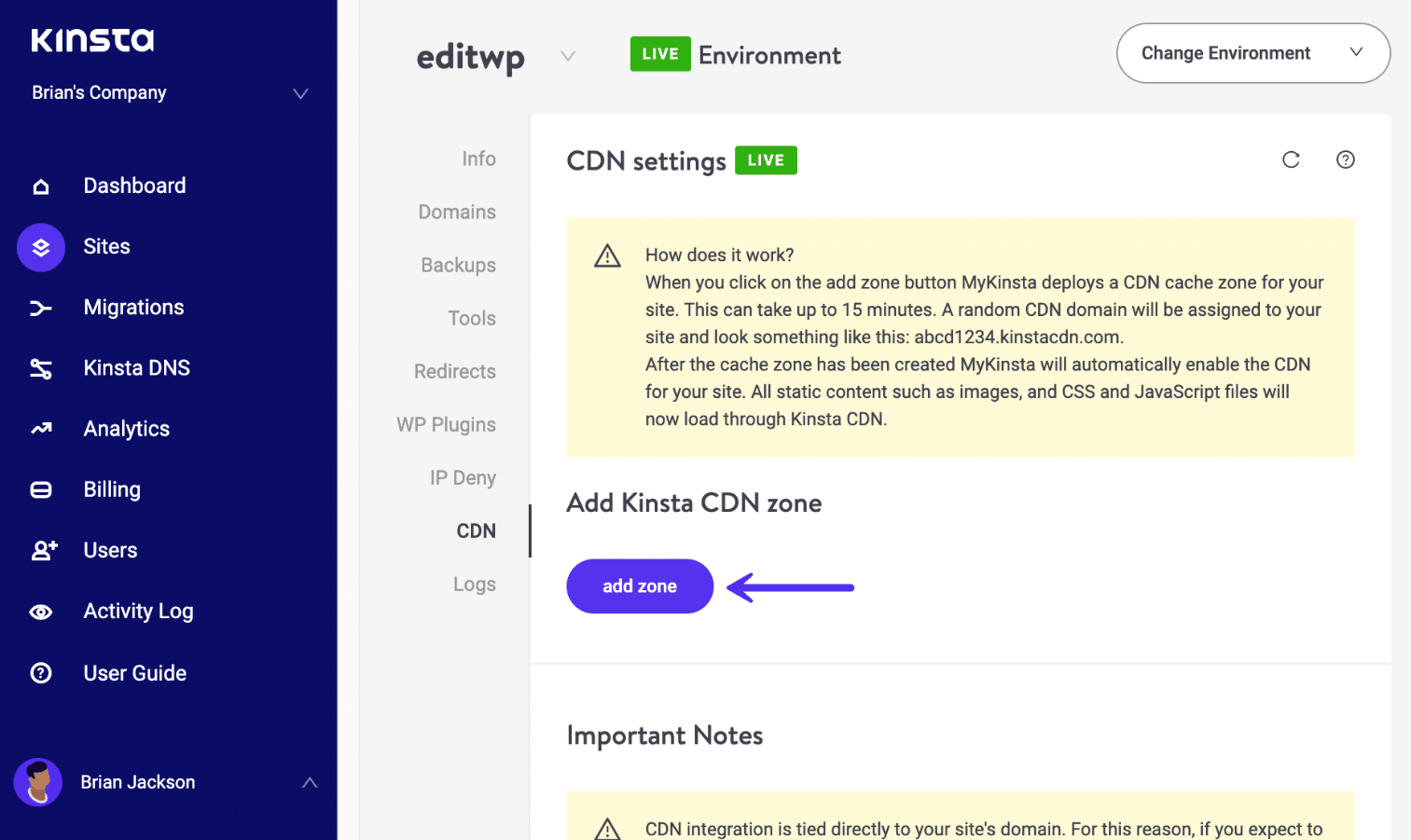
If you are using or interested in Cloudflare, we have an in-depth tutorial on how to install Cloudflare on your WordPress site. We also recommend checking out our comparison of the Kinsta CDN vs Cloudflare.
Third-party CDN providers should have the documentation you can follow to set up their CDN on your WordPress site. You can then use a free plugin like CDN Enabler.
How to Properly Run a Website Speed Test
Now that you have caching configured and a CDN enabled, it’s now time to dive into how to properly speed test your WordPress site. There are a lot of different tools you can use to measure the performance of your site. You can check out a full list further below. For this example, we are going to using Pingdom, one of the most popular and commonly used tools.
Speed Test Location Matters
Almost every speed test tool allows you to choose from different testing locations around the globe, and this matters quite a bit. The reason is that this is all relative to the data center where your WordPress site is hosted. TTFB, network latency, all come into play. If you’re a Kinsta client, we have 20 different data centers you can choose from for your sites.
So it’s important to speed test your site both from a location that is close to your data center and one that is far away. This will also help you see how much of an impact the CDN has on your WordPress site. You can also disable your CDN temporarily and re-test again without to really see the difference.
Whatever you do, be consistent with the location you choose.
You Have to Test Multiple Times
We won’t go too deep into caching in this article, but just remember that this is what makes your WordPress site load super fast (both caching from your WordPress host or plugin and your CDN).
The big problem is that many users tend to only run a speed test once, the content isn’t cached on the WordPress host or CDN yet, and then it appears that the site is actually slower. This can also happen if you just cleared your WordPress site or CDN’s cache.
How can you tell that your content or media isn’t serving from cache? It’s easy. Every speed test tool shows you what are called HTTP headers (also known as response headers). These contain important information about each request.
We have a development site set up at Kinsta with the Kinsta CDN enabled. We first tested it through Pingdom and get the following result.
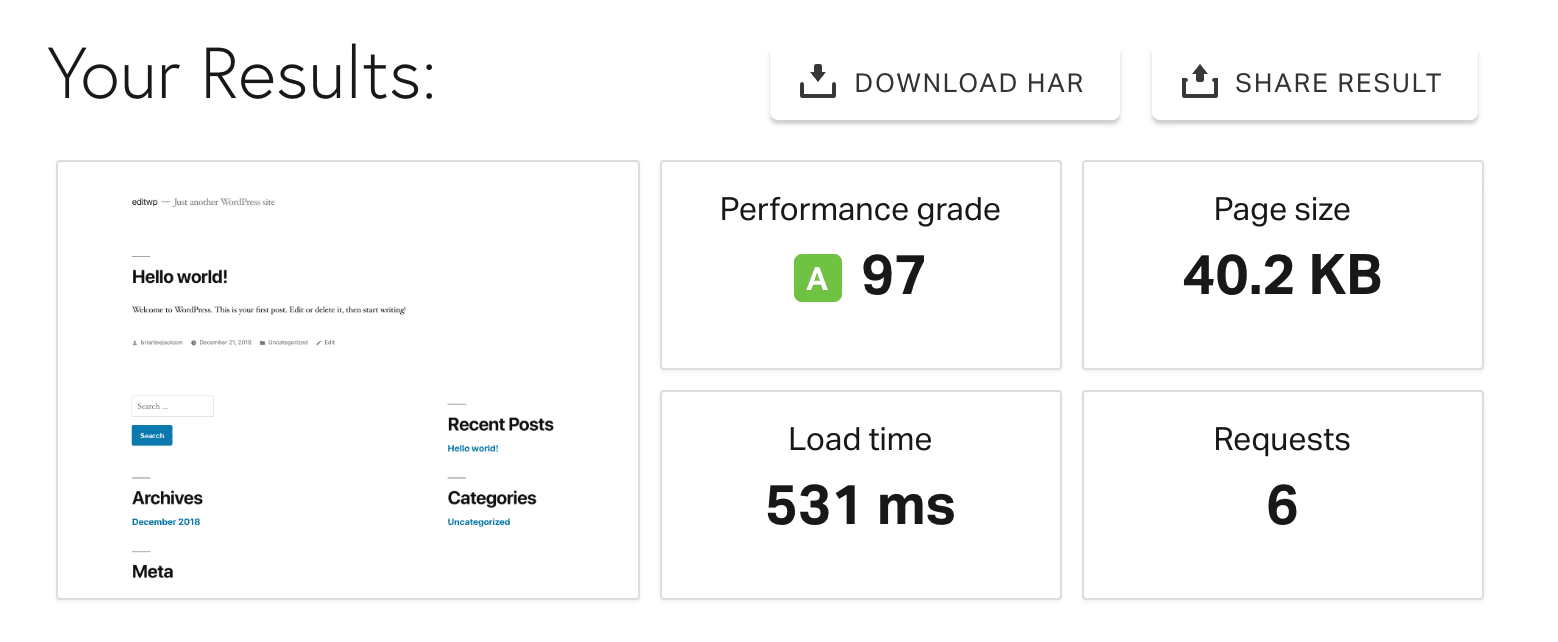
If you take a look at the example below, the first request is to the primary domain and this is loading directly from the Kinsta server. Below that, you can see the rest of the requests are loading from the Kinsta CDN (xxxx.kinstacdn.com).
If you look at the request to the Kinsta server, you will see a header called x-kinsta-cache. When it’s not serving from cache yet it will register a MISS. The name of this header might vary slightly based on your hosting provider.
The Kinsta CDN requests below that are the same way. Look for the header called x-cache. When it’s not serving from cache yet it will register a MISS. Again, the name of the header might vary slightly based on your CDN provider. For example, when you’re using Cloudflare, the HTTP header is called cf-cache-status.
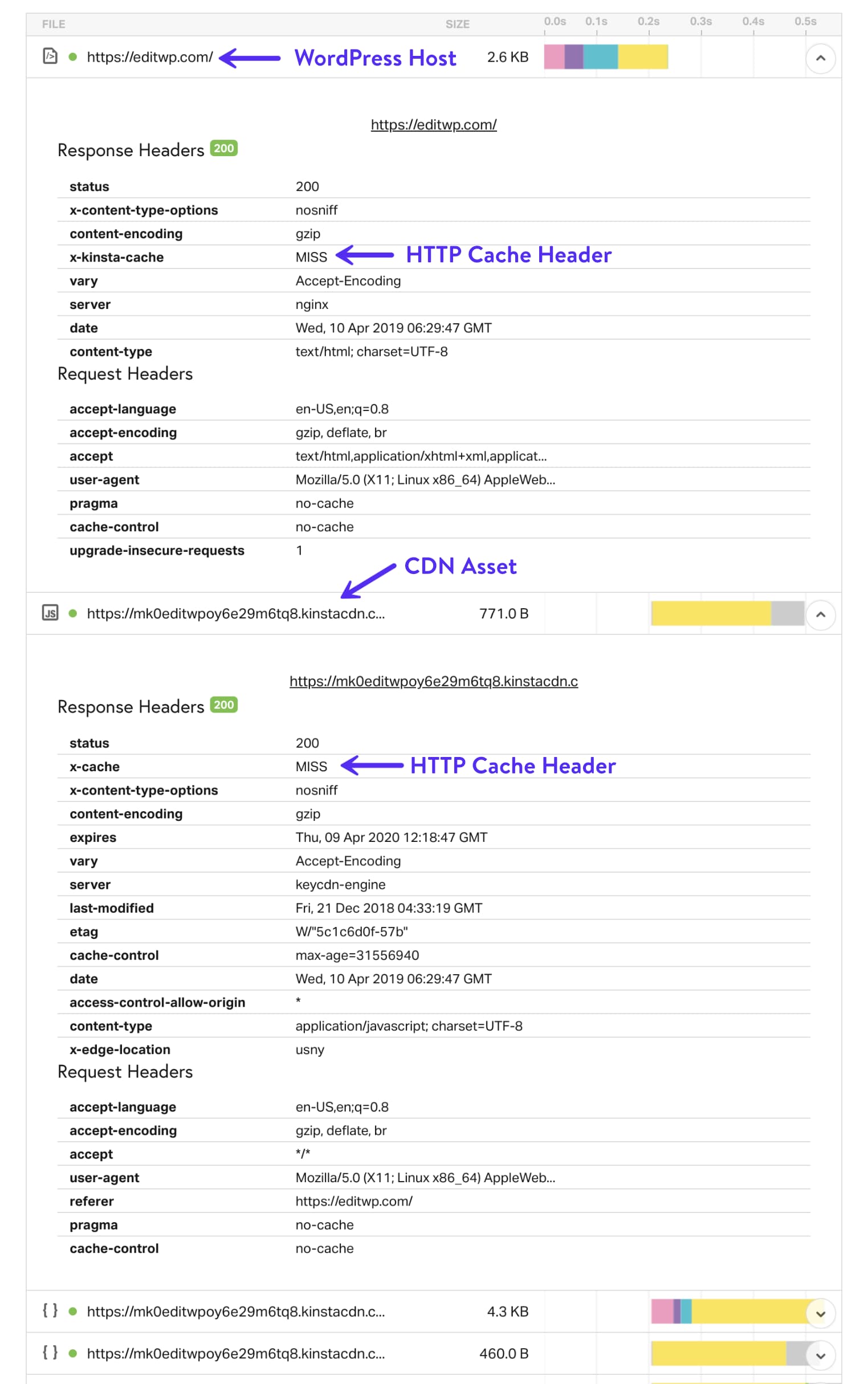
To properly speed test, you need to see everything load from cache (both from your WordPress host and CDN). When it is, the x-kinsta-cache and x-cache headers will register a HIT (as seen below). This usually requires running your speed test multiple times. We have found that two or three is usually the magic number. Some speed test tools like Pingdom also limit the time between each test (usually a couple minutes). So you might have to run your speed test, come back later, run it again, etc.
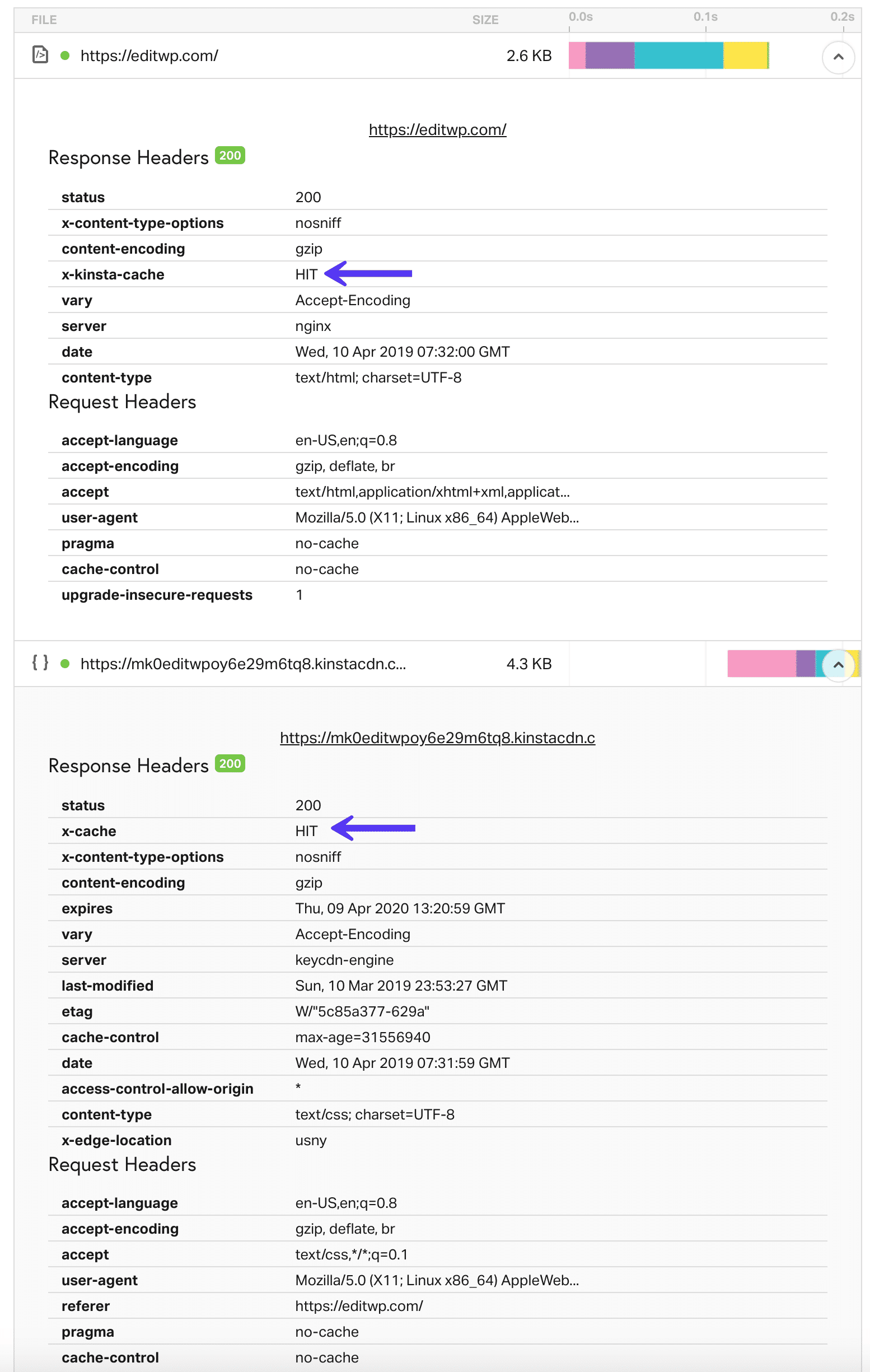
It is also possible that your WordPress host will register a HIT with cache before your CDN. You can quickly scan down the test and look for the large yellow bar. This indicates TTFB (wait time), which is what spikes really high when a page or asset isn’t delivered from cache.
Why does this matter so much? Because if you look at our speed test before and after, the site that loaded entirely from cache was over 50% faster. And this was on our small development site. On larger sites, the percentage will be even bigger. This is why it’s vital that you understand how to speed test your website properly.
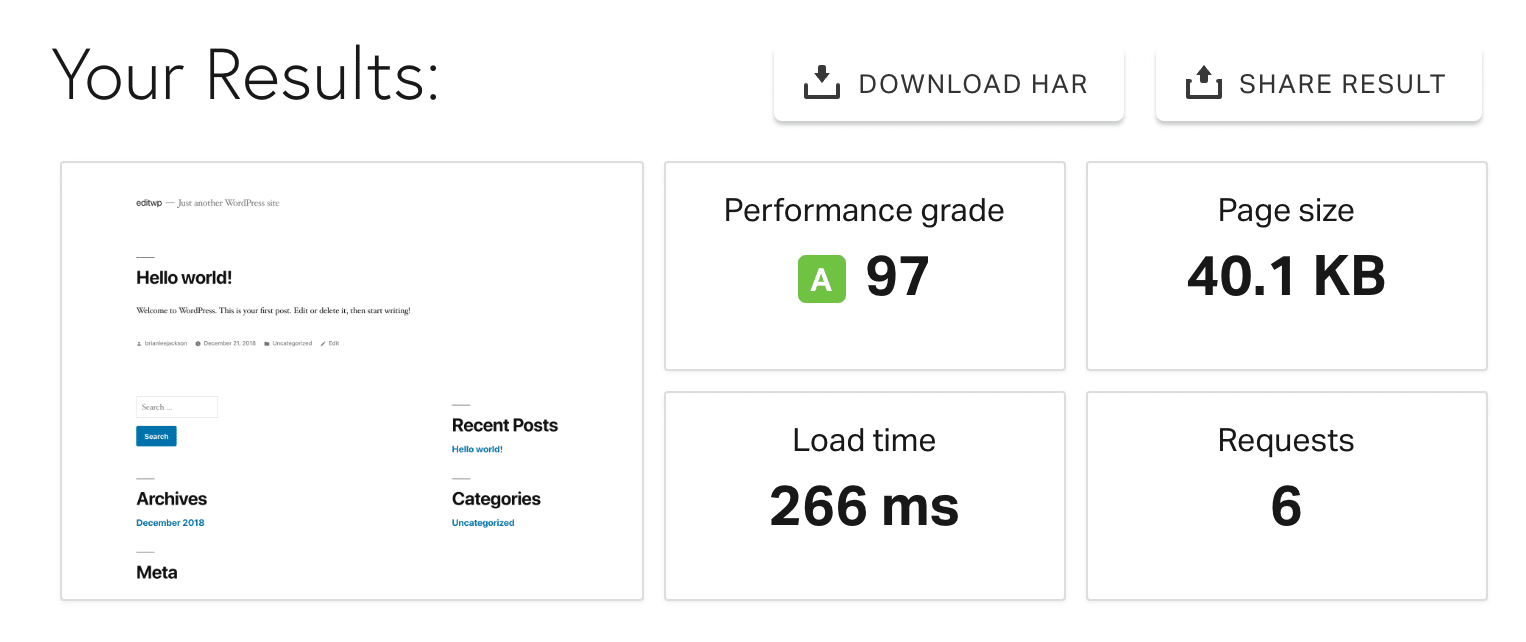
Besides the requests to your hosting provider and CDN, you will most likely also have external requests to things such as Facebook, Google Analytics, Google Fonts, etc. Troubleshooting these is an issue for another day. ? Check out our post on how to identify and analyze external services on your WordPress site, our ultimate Pingdom guide, and our in-depth guide on how to change font in WordPress.
Best Website Speed Test Tools in 2019
Now it’s time to dive into all the different website speed test tools you can use. What’s the optimal load time that you should be aiming for? Well, the faster the better, but most experts suggest that around two seconds or less is a good target. Remember too that there is a difference between perceived performance and actual performance.
- Pingdom
- Google PageSpeed Insights
- Google Mobile Website Speed Testing Tool
- Google Analytics Site Speed
- WebPageTest
- GTMetrix
- KeyCDN Website Speed Test
- DareBoost
- Web Page Analyzer
- YSlow
- Chrome DevTools
- Load Impact
- Site Relic
- dotcom-monitor
- New Relic
One of the most important things when it comes to website speed testing is to pick one tool and stick with it. Each has its own set of different metrics and therefore you can’t compare one tool’s test results to another. There is no right or wrong tool, you should simply focus on making improvements. Gary Illyes, Webmaster Trends Analyst from Google, sums it up well.
Each tool has a set of different metrics but each metric on its own makes perfect sense to improve. No tool is perfect and normally I’d tell you which one is the closest, but in this case is really about picking one that you like.112:59 PM – Jul 12, 2018 · Rajendra Nagar, IndiaTwitter Ads info and privacySee Gary “鯨理/경리” Illyes’s other Tweets
1. Pingdom
Pingdom is a market-leading website monitoring service, best known for its free website speed testing tool. The speed testing tool displays all of your site’s requests in a waterfall view. You can filter by load order, file size, and load times, giving you different perspectives for identifying potential improvements – it also lists total requests, load time, and page size.
It has gained popularity over the years due to the fact that it is super easy to use, especially when compared to similar speed test tools. For beginners, Pingdom can be a great way to start.
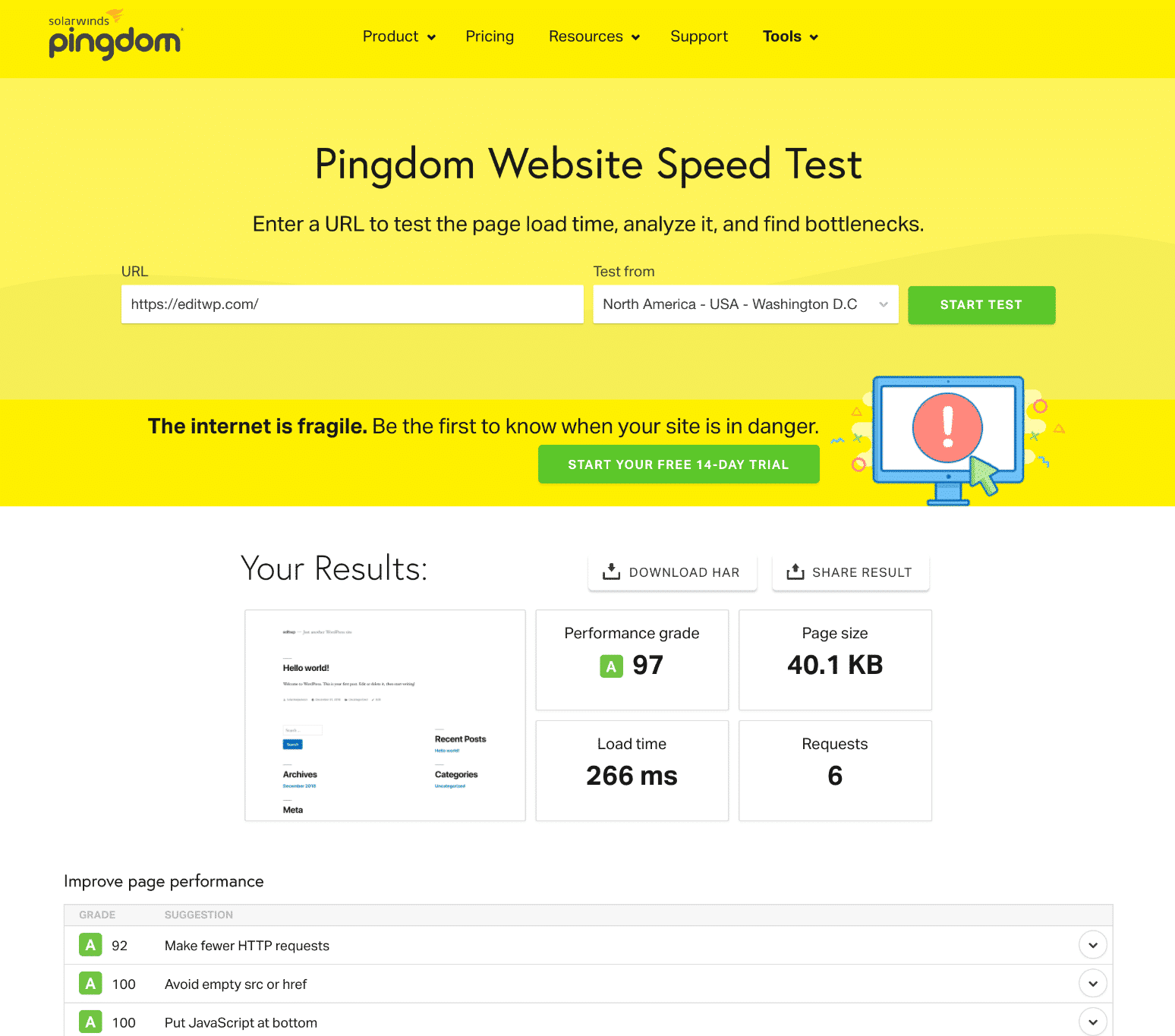
Pingdom also gives you a speed performance rating, scored out of 100. This rating is broken down into twelve criteria, with each given an individual score. Again, this is helpful for identifying the “quick wins” you can target to make instant, tangible improvements to your site’s speed. It is possible to score a 100 score. However, don’t obsess too much over scores, as they don’t matter as much as simply making improvements on your site to speed it up.
Pingdom stores the results of all tests performed on your website, allowing you to historically track speed improvements over time.
2. Google PageSpeed Insights
Google has said since 2010 that page speed is an important ranking factor for SEO. To help you improve your site’s speed, Google has its very own speed testing tool, Google PageSpeed Insights, which measures the performance of a page for mobile devices and desktop devices.

The PageSpeed Score ranges from 0 to 100 points, and is based on Lighthouse. A higher score is better and a score of 85 or above indicates that the page is performing well. The report page gives you a useful breakdown of the steps you can take to improve performance. PageSpeed Insights also provides you with additional user experience suggestions for mobile devices. Check out our thoughts on whether or not it’s possible to score a 100/100 score on PageSpeed Insights.
If you care about elevating your website to the top of the SERPs, it pays to listen to what Google recommends. We also have a walk-through on how to fix that stubborn leverage browser caching warning.
3. Google Mobile Website Speed Testing Tool
According to Google, people are 5 times more likely to leave a site if it isn’t mobile-friendly. That is why they released their mobile website speed testing tool. This tool is actually powered by Google PageSpeed Insights, and is aimed more toward marketers and agencies to better deliver easy to understand optimization reports.
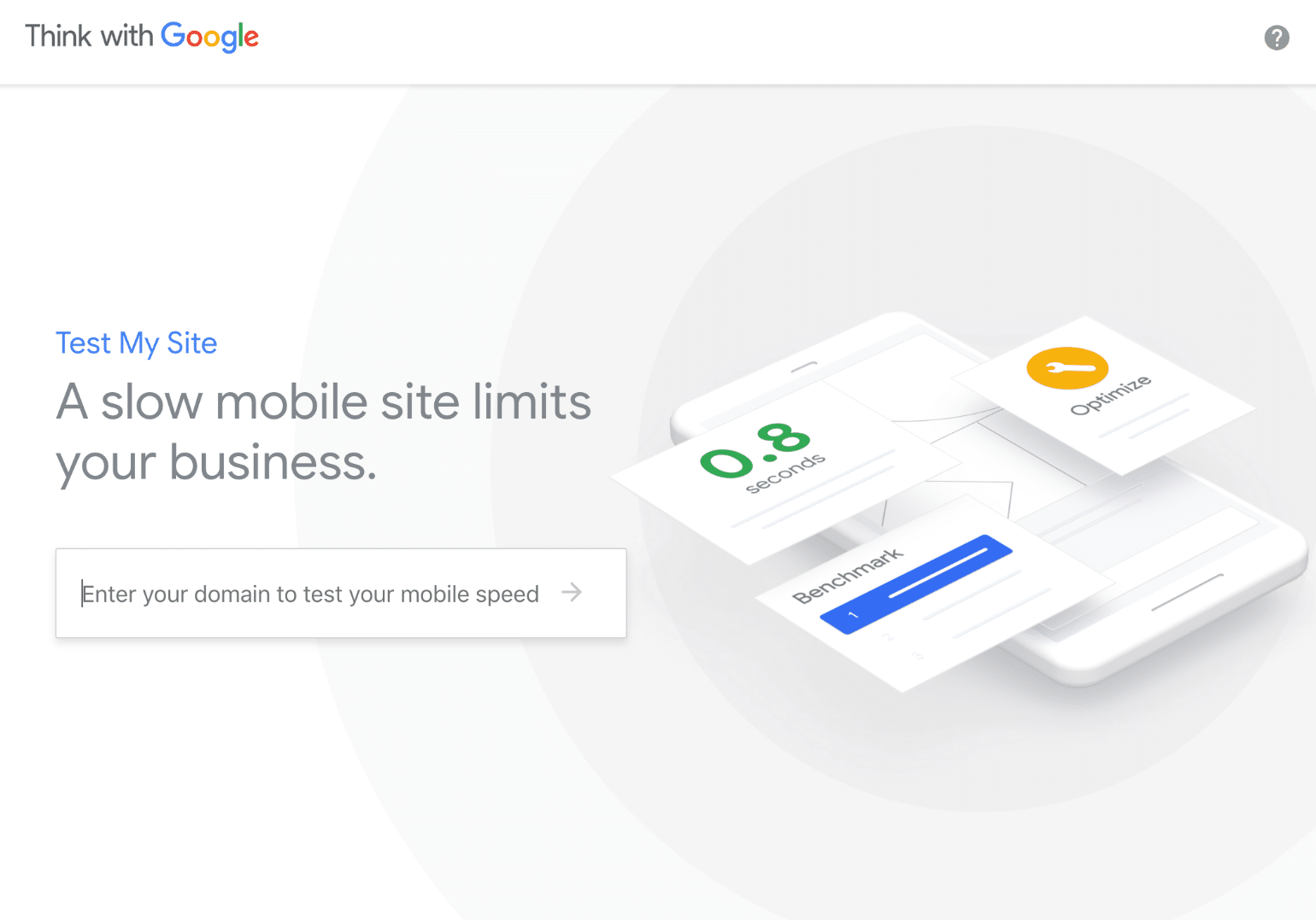
You can get reports sent right to your email, or forward the information along to your webmaster or developer. However, remember that a 100/100 score might not even be possible in all scenarios, depending on how your WordPress site is set up. With a lot of multipurpose themes and sites with dozens of external scripts, you simply will have an almost impossible time trying to achieve a perfect score. Which is perfectly OK. And definitely not the developer’s fault.
4. Google Analytics Site Speed
Google Analytics also has the ability to measure site speed. This exists in your GA dashboard under the “Behavior” menu. It captures information via a snippet of code included in a web page. Their site speed reports measure three aspects of latency:
- Page-load time for a sample of pageviews on your site.
- Execution speed or load time of any discrete hit, event, or user interaction that you want to track.
- How quickly the browser parses the document and makes it available for user interaction.

While this can be helpful as an overall comparison, we generally recommend not using this as we’ve found the data to not always be accurate or a clear depiction of what’s really happening on the site. Why? because it’s collected from a random sampling of data.
Joe has a great write up the problem with site speed accuracy in Google Analytics. Yotta has also reported on frequent errors which can throw off the site speed averages substantially. We recommend using one of the other speed test tools mentioned in this post.
5. WebPageTest
WebPagetest was created by Patrick Meenan, a Chrome engineer at Google. It is an open source project and allows you to run a free website speed test from multiple locations around the globe using real browsers (IE, Chrome, etc). For you more advanced users needing to get additional data from your speed tests, this is a great tool.
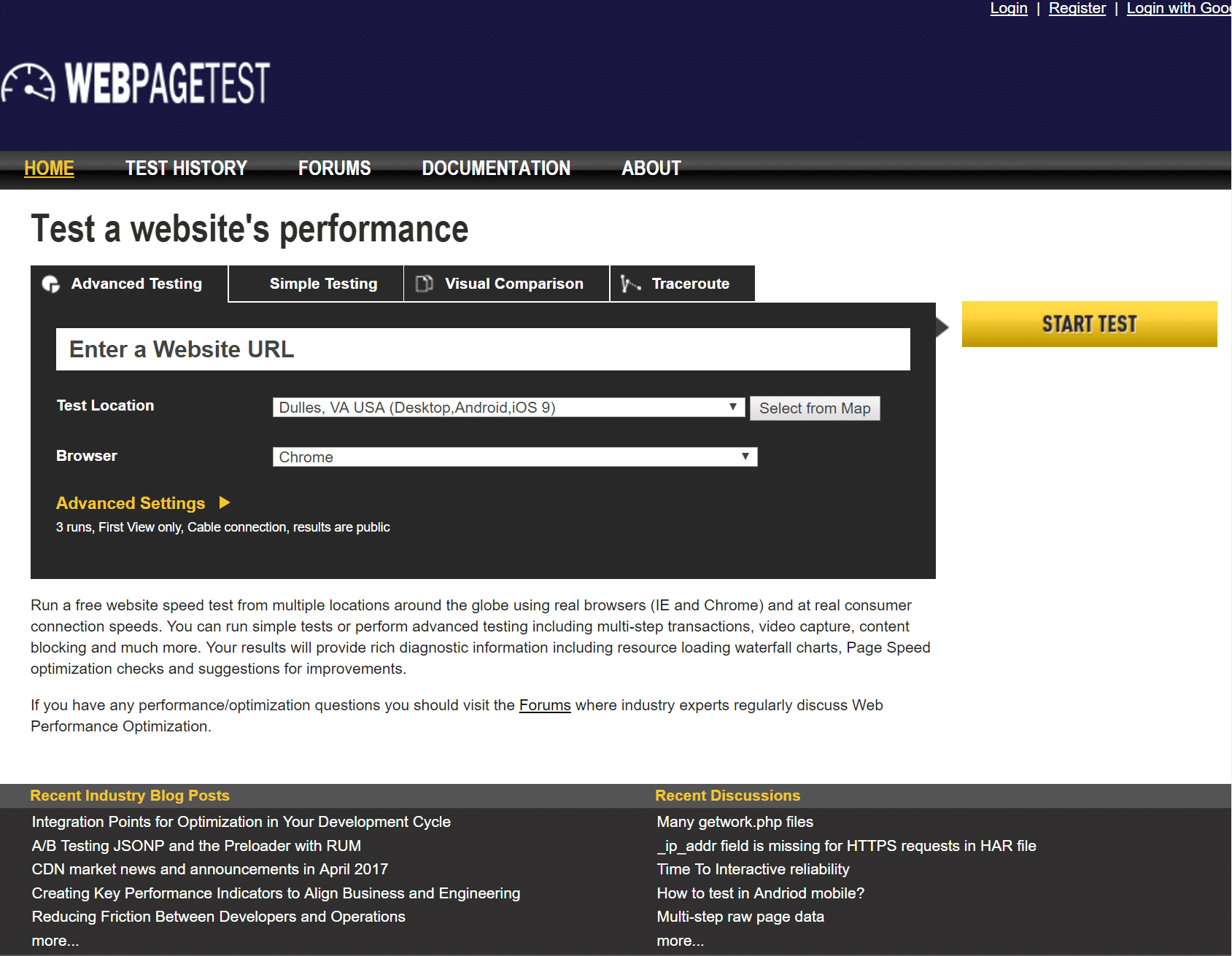
WebPageTest allows you to perform advanced tests including multi-step transactions, capture video, content blocking, compare first view verses repeat view, change the connection speed, and much more. Their waterfall charts and resource loading reports provide lots of additional information regarding improvements that can be made across your site.
6. GTmetrix
GTmetrix is another popular speed analysis tool, and arguably the best-known of all the Pingdom alternatives. It is easy to use and beginners can pick it up quite fast. The tool provides comprehensive analysis by combining the performance and recommendations provided by Google PageSpeed Insights and YSlow. This means that GTmetrix is effectively a one-stop-shop for all of your speed optimization needs.
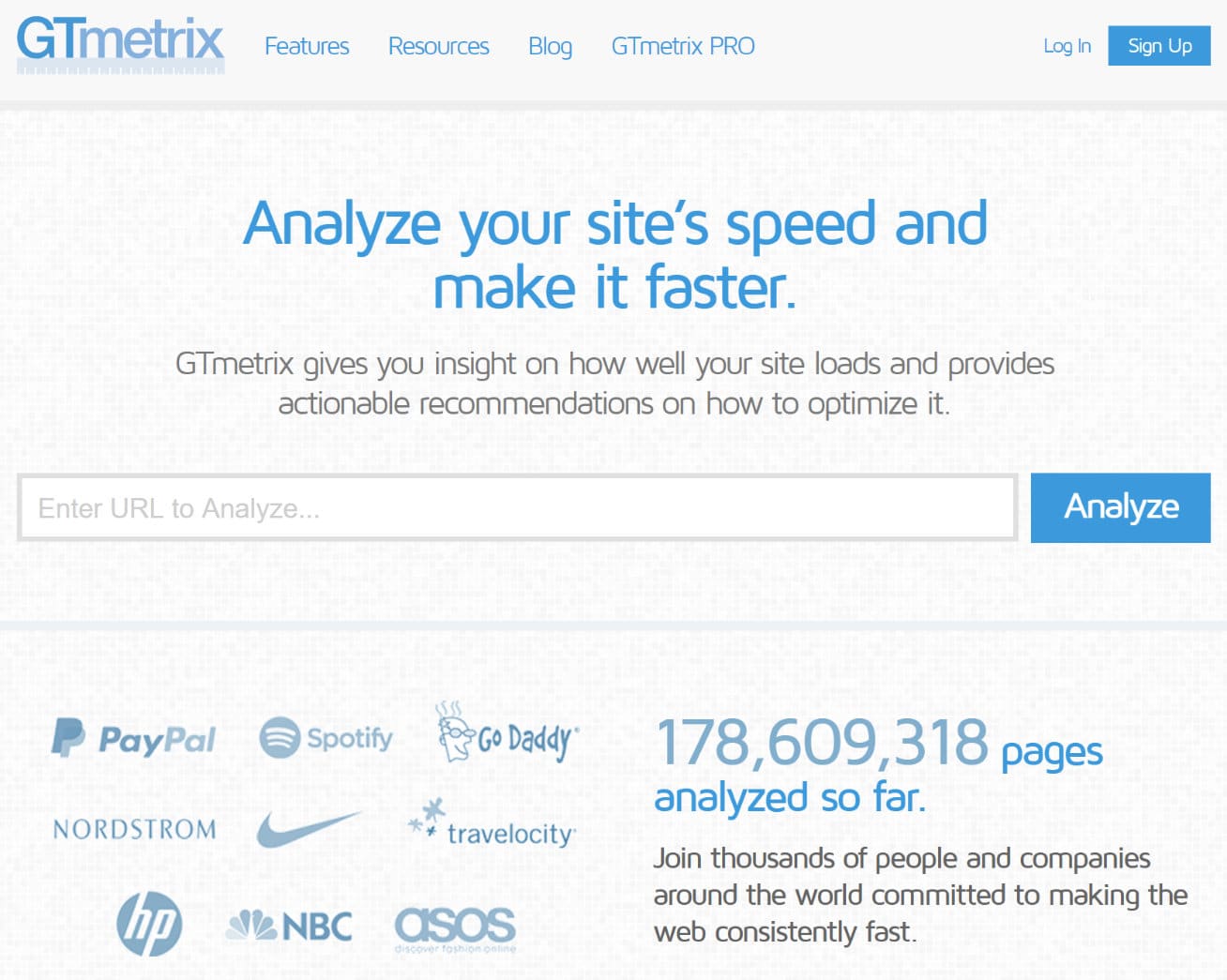
To ensure that your top-level data is easier to digest, GTmetrix displays a summary at the top of the page, listing your total page load time, page size, and number of requests. The tool also displays a list of your requests in a waterfall chart, enabling you to identify problem areas and bottlenecks with ease. The waterfall chart can be downloaded, too, so that you can perform further analysis.
You can create a free account in which allows you to save the last 20 tests, compare historical data, and have pre-configured settings for testing locations, browsers, connection speeds, and more.
Make sure to also check out our in-depth guide where we dive into how to use the GTmetrix speed test tool.
7. KeyCDN Website Speed Test
KeyCDN’s free website speed test tool provides an incredibly fast and easy way to determine the overall speed of your WordPress site. The simple page speed test includes a waterfall breakdown and a website preview. You can select from 14 different test locations, strategically located around the globe, in order to better determine the overall download time of your assets from that physical region.
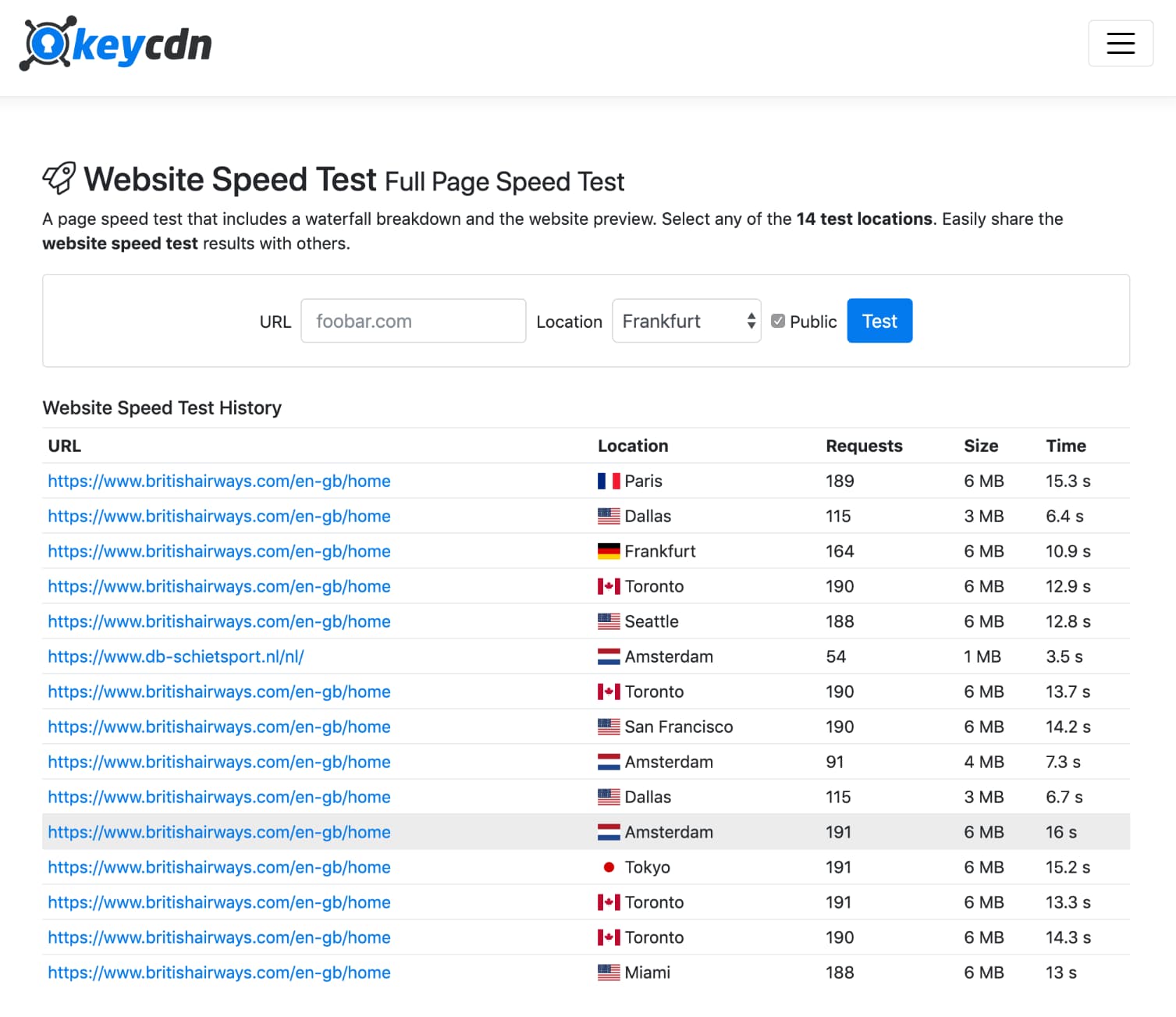
You can run both a private and public test in which you can then later share or bookmark for future reference. The breakdown report shows a great overview of the request methods (GET/POST), HTTP status codes (such as 200 OK or 404), file types, content size, wait/receive time, total download time, and the overall number of HTTP requests generated on your site. KeyCDN also has other free handy web performance testing tools such as Ping Test, HTTP/2 Test, HTTP Check, and Traceroute Tool.
8. DareBoost
DareBoost is an all-in-one service for website speed testing, web performance monitoring, and website analysis (speed, SEO, quality, security). And while they are primarily a premium service, you can use their website speed test tool for 5 free reports per month, minus a few advanced features for paid customers. The free reports are actually pretty impressive!
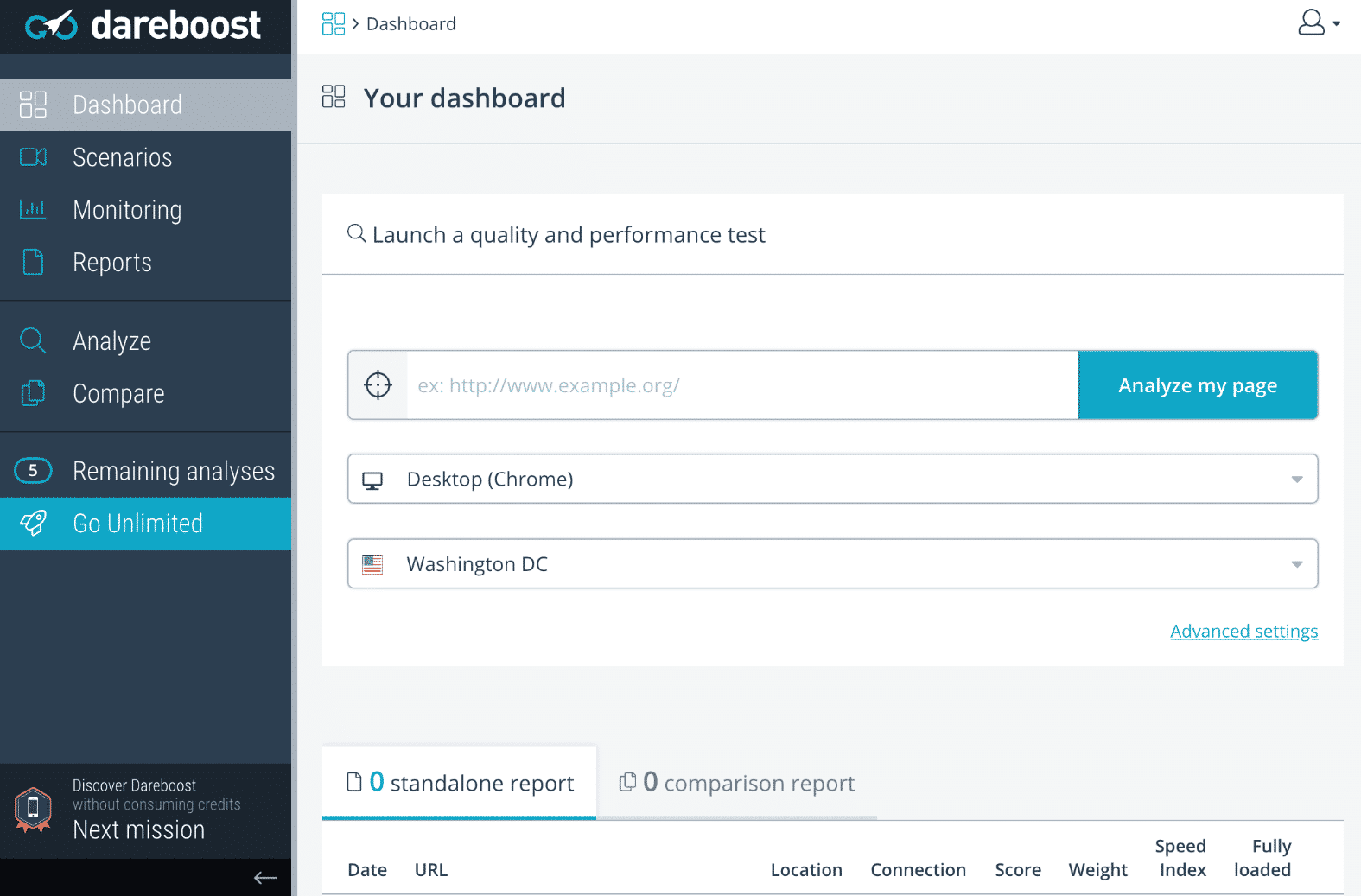
The DareBoost speed test report analyzes over 80 different data points, across the following categories:
- Cache policy
- Number of requests
- Security
- Accessibility
- Compliance
- Quality
- jQuery
- Browser Rendering
- Data amount
- SEO
You can quickly see where your WordPress site is struggling and needs work. The security reporting is also very unique when compared to the other tools we have mentioned. You can see things such as if your website is exposed to clickjacking attack, you are missing a content security policy header, and even information about your SSL certificate. Their design is pretty awesome too! If you are needing a report for your boss or agency, this might be a tool you want to check out.
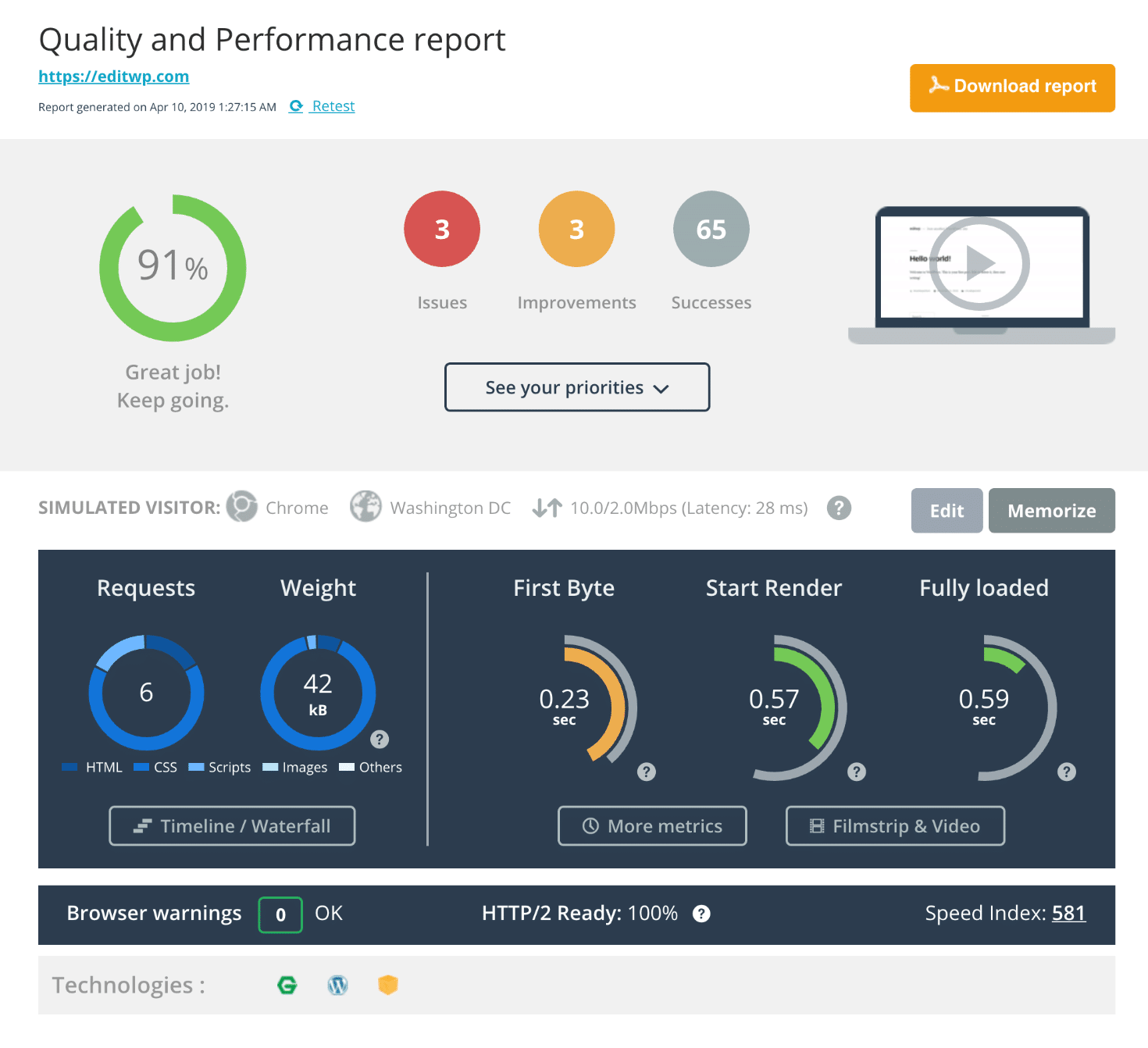
9. Web Page Analyzer
The Web Page Analyzer is a highly recommended free tool for analyzing your site’s speed, size, and composition. The script calculates the size of individual elements and sums up each type of web page component. Based on these page characteristics the script then offers advice on how to improve page load time.
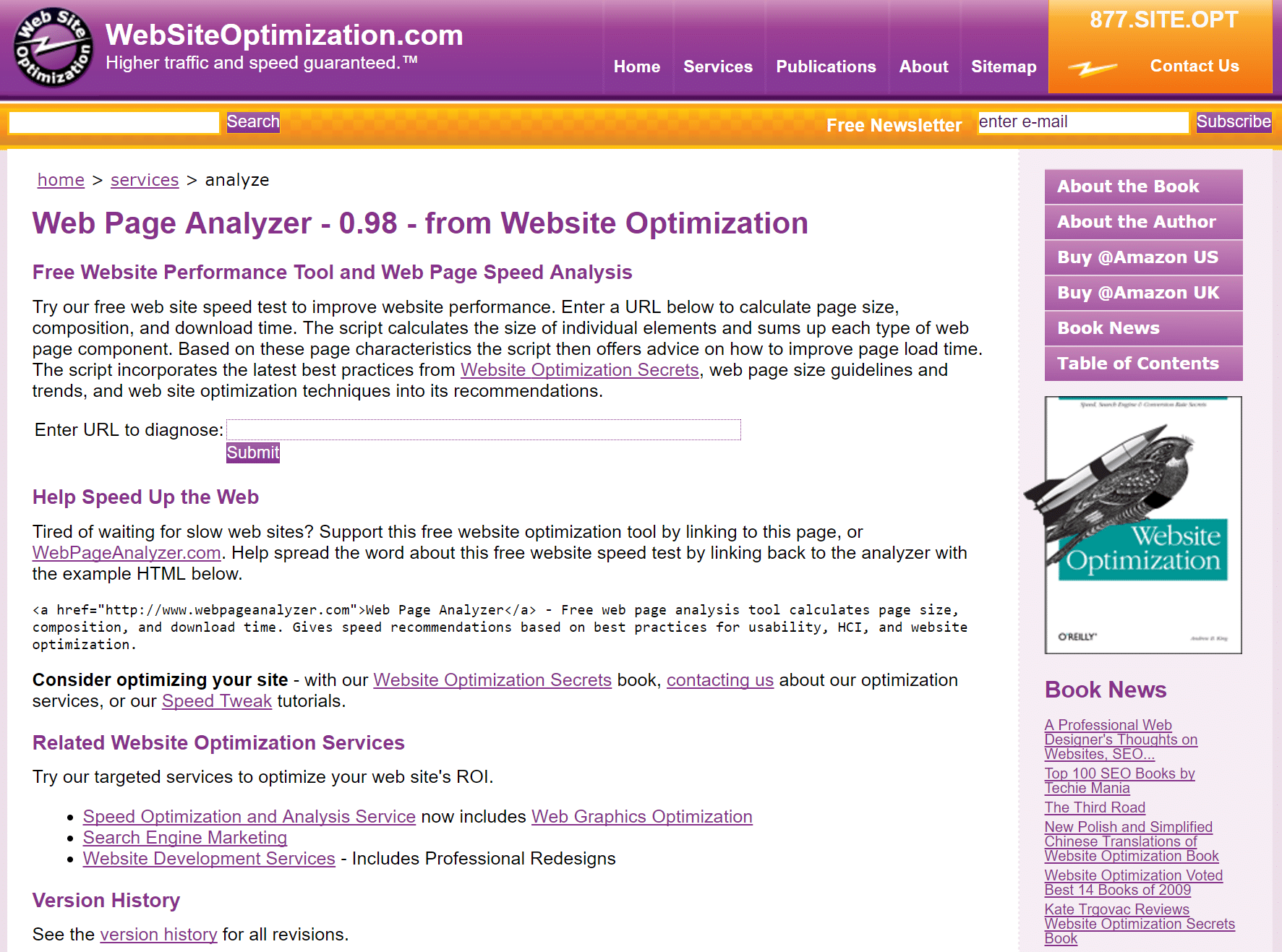
More specifically, the tool will tell you how long your website takes to load for different connection speeds. If you like your data detailed, the Web Page Analyzer tool breaks it down for you, displaying the size and a comment for each. At the bottom of the analysis, the tool provides comments and recommendations on 11 specific aspects of your site’s performance – including telling you the areas where you perform well. It appears this tool hasn’t been updated though for a while, so don’t expect things like HTTP/2 support.
10. YSlow
Next up, Yahoo!’s page performance tool, YSlow. The tool requires installation as an add-on for your browser, but is completely free to use – and most popular web browsers are supported.
The Yahoo! team has identified 34 factors that impact a website’s speed. Unfortunately, only 23 can be tested quantitatively, and so the tool focuses its analysis on these areas – the YSlow website lists these 23 “rules” with extended details, which are well worth checking out. With the analysis complete, YSlow will grade you for each area – scored from A to F. This makes it super-easy to spot your weaker areas, which you can target for the biggest steps forward in terms of site speed.
This used to be the most popular speed testing tool. But unfortunately, the YSlow project is no longer maintained. Their last commit was 2 years ago and there are over 100 open issues on their GitHub page. However, there is still some useful information that the extension provides, but we would recommend using a newer and actively supported website speed test tool.
11. Chrome DevTools
The Chrome DevTools network panel is part of Chrome. This is a very popular tool among developers as it is easily accessible and a great for local debugging and testing. You can easily launch the network panel in Chrome by pressing Command+Option+I (Mac) or Control+Shift+I (Windows, Linux). You can then generate a waterfall analysis of your site and dig into the performance of each of your assets.
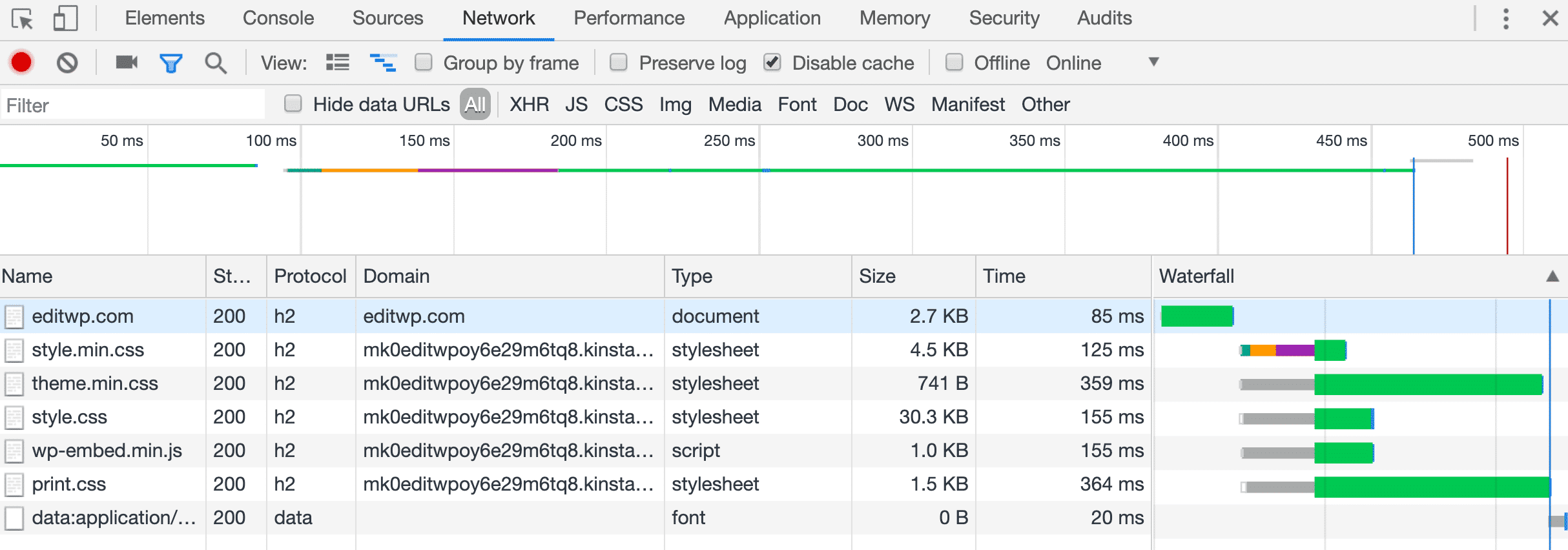
Another great feature added in Chrome 60 is the ability to block requests. This can be very useful when trying to determine how much overhead a 3rd-party service or script is having on your site.
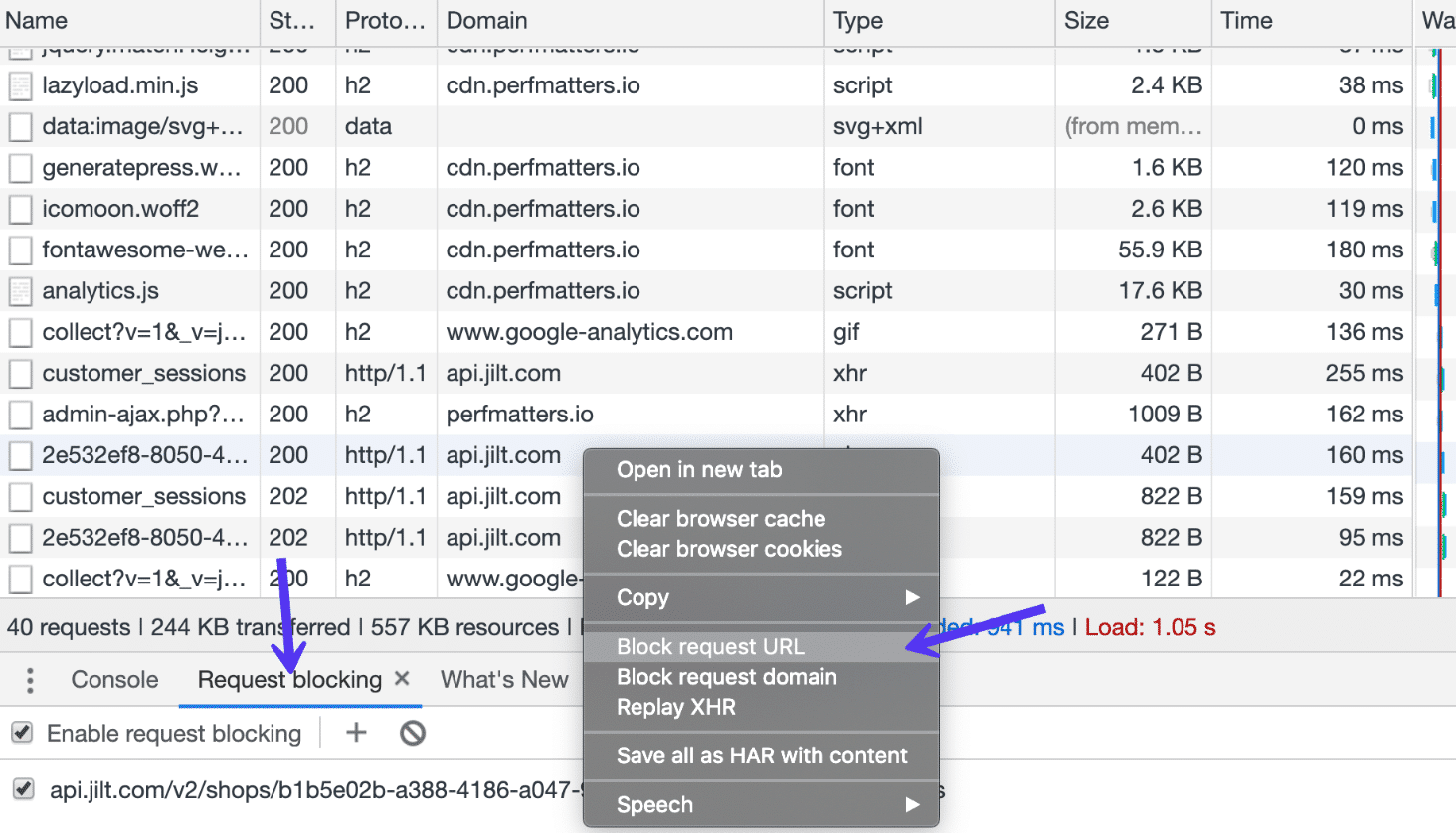
The team at Google also integrated Lighthouse into Chrome Devtools. Lighthouse is an open-source, automated tool for improving the quality of web pages. It has audits for performance, accessibility, progressive web apps, and more. You can run it from the “Audit” tab. It has a similar 0 out of 100 grading system. You can dive into your requests, see what scripts might be render-blocking, image compression savings, etc. You can then easily share the link with others.

Other features in Chrome Devtools include being able to disable the cache, throttle your network connections, take screenshots of page rendering, and diagnose slow TTFB.
12. Load Impact
Load Impact is one of the best tools out there for testing how scalable your website is. They offer a free website performance test (5 reports per month), analyzing the consequences of having 25 concurrent users on your website and the impact this modest traffic has on-site speed.
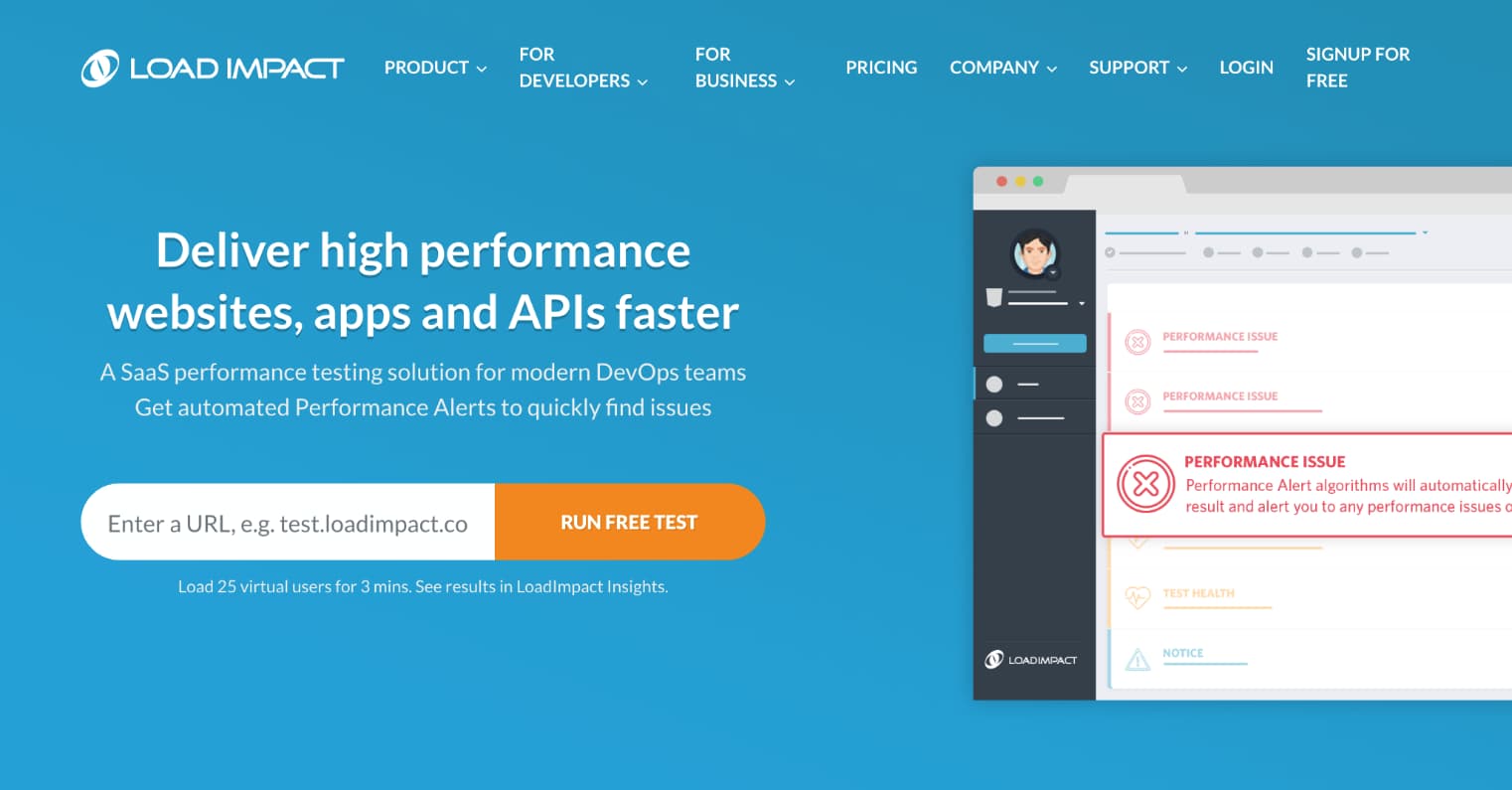
Load Impact displays a handy graph, demonstrating how your load time changes when more users visit your website. To ensure your site caters to a truly global audience, Load Impact will also send virtual users to your website from different locations.

Want more? Load Impact conveniently displays top-level statistics such as bandwidth usage, requests made, and the number of requests per second. If you want extra data, considering upgrading to one of Load Impact’s premium plans – this allows you to test the impact of far greater volumes of concurrent users. The premium plans are available from $89/month.
13. Site Relic
Site Relic is another completely free website speed test tool that has popped up recently. It allows you to easily check your site’s load time on both mobile and desktop across 9 different regions. You can also view your TTFB across all regions at once.
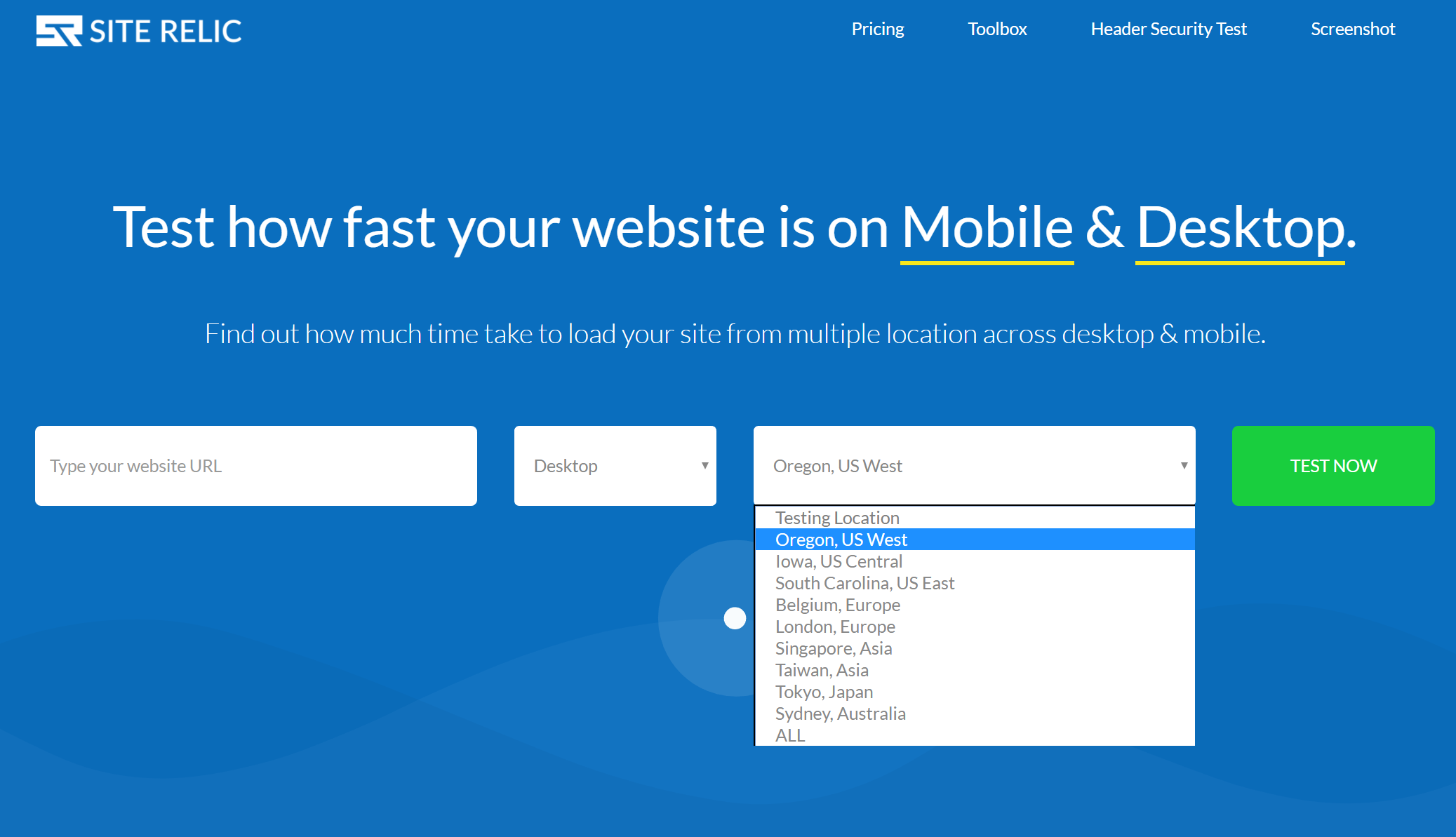
Individual location reports allow you to easily see your fully loaded time, page size, first byte, total number of requests, request counts by type, and request counts by response code. The waterfall report in the tool is also very well designed.

14. dotcom-monitor
dotcom-monitor has a lot of free and useful tools. One of which is their website speed test tool. It allows you to instantly test your website’s speed from 25 locations around the globe. You can choose between different browsers such as Internet Explorer, Firefox, Chrome, iOS, Android, Windows Phone, and Blackberry.
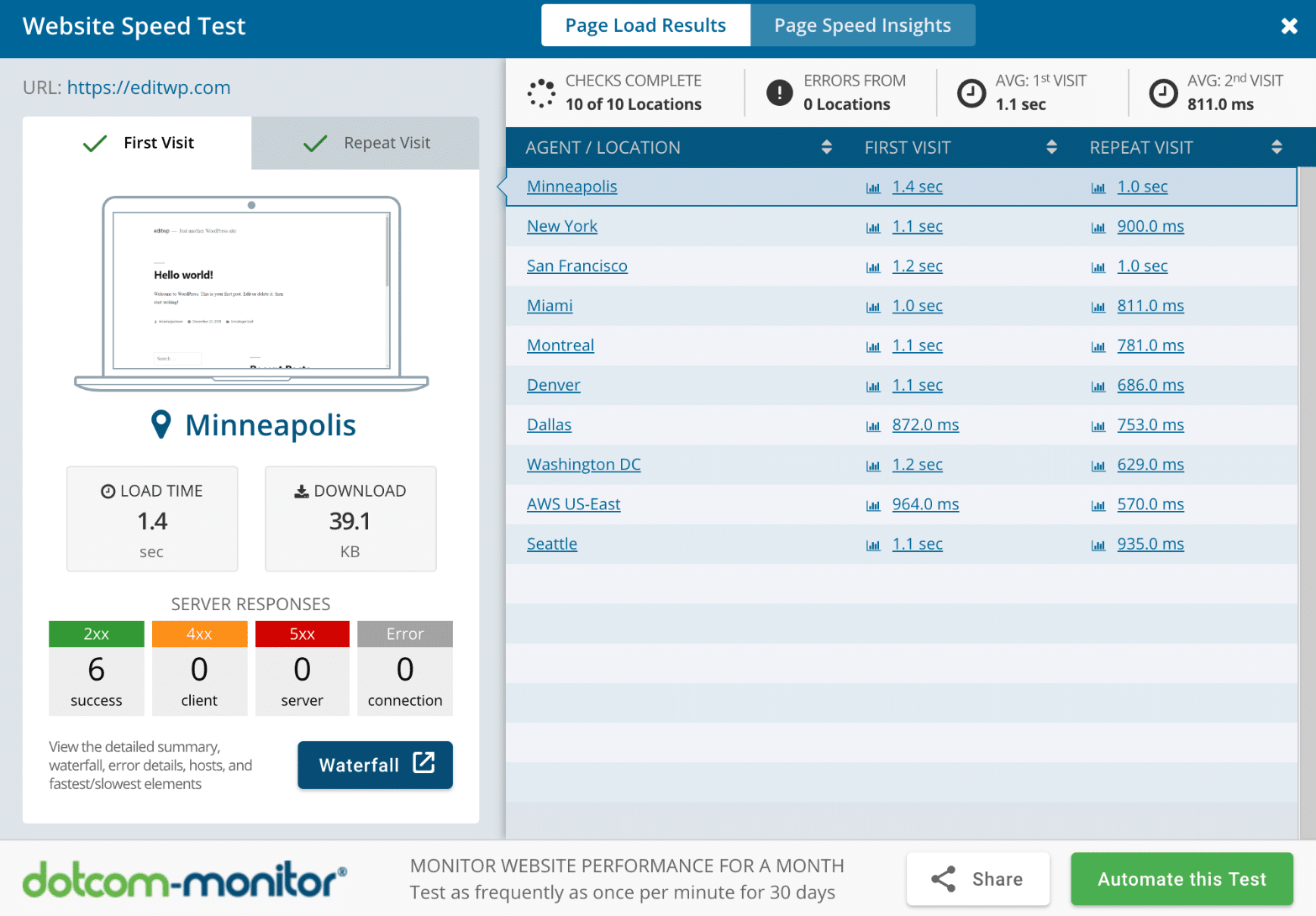
Their web performance report includes:
- Summary by location
- 10% of fastest elements
- 10% of slowest elements
- Comprehensive waterfall chart
- Breakdown by host element – including DNS, Connection, SSL, Request, First packet, and Download
- Error check and diagnostics
15. New Relic
New Relic offers all sorts of services, from application performance monitoring, server monitoring, mobile monitoring, and real-time user insights. Technically this is a premium tool, but if you need more data than what the above tools provide, this would be the one you want to invest in.
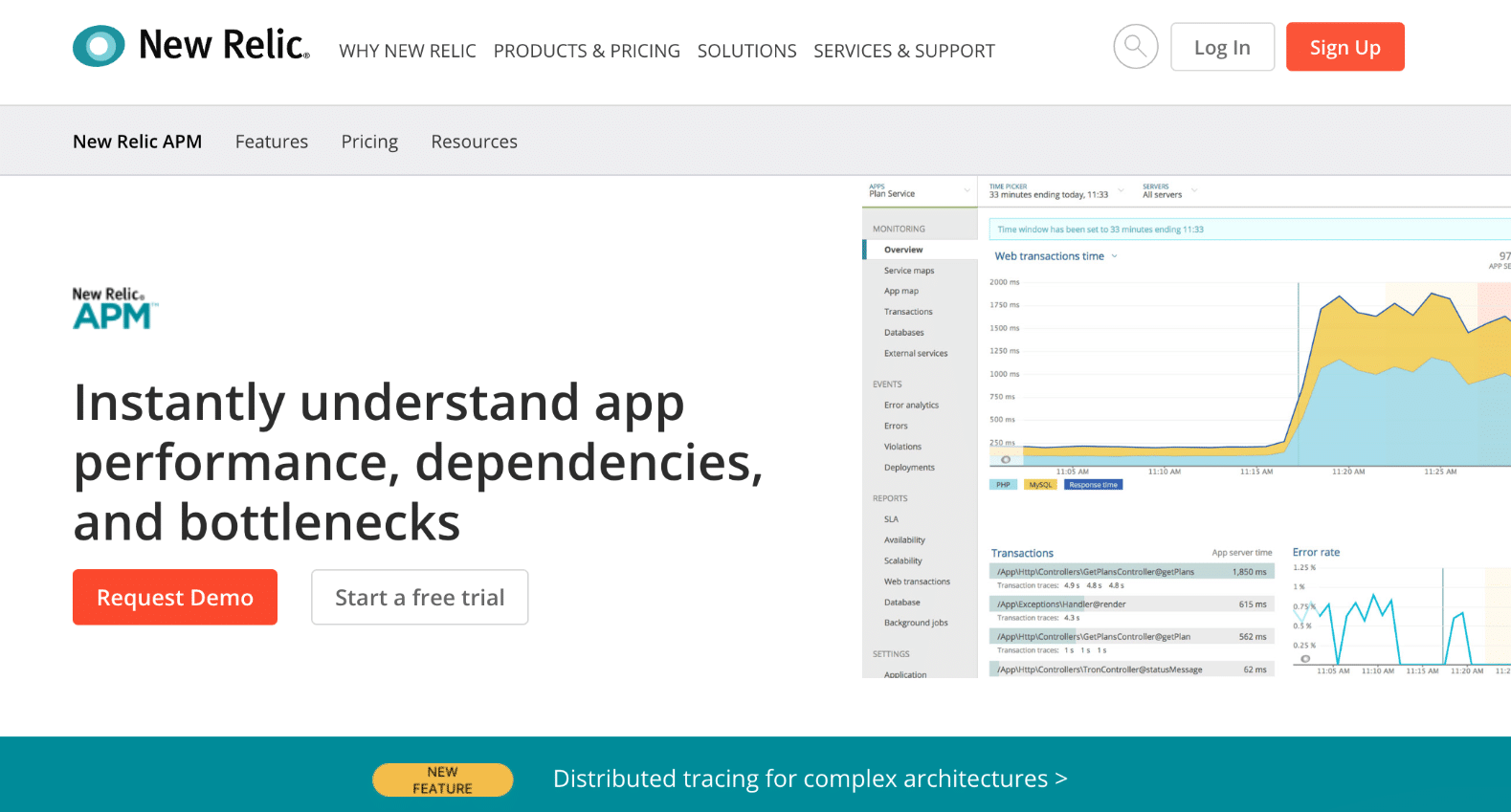
New Relic
We actually use two of New Relic’s products here at Kinsta to monitor uptime and performance, and that is their application monitoring and synthetics products.
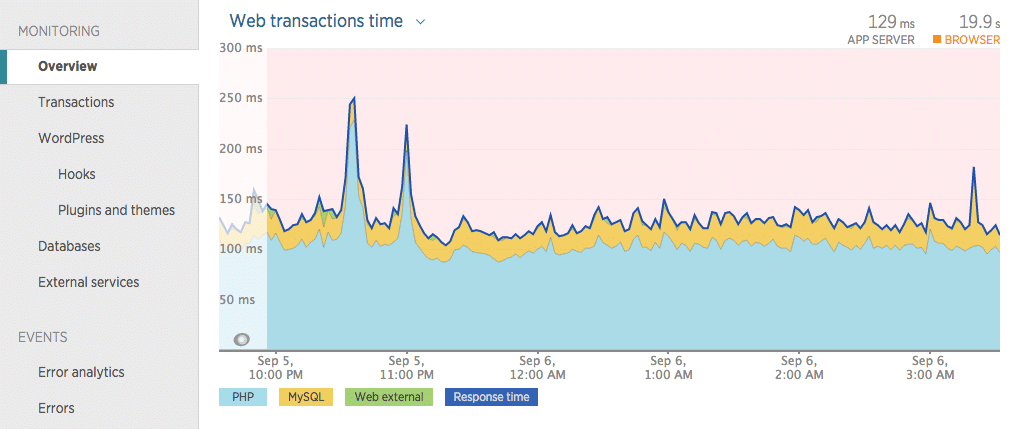
One especially useful feature is the WordPress plugins section. You can instantly see which plugins and themes have the longest response times.
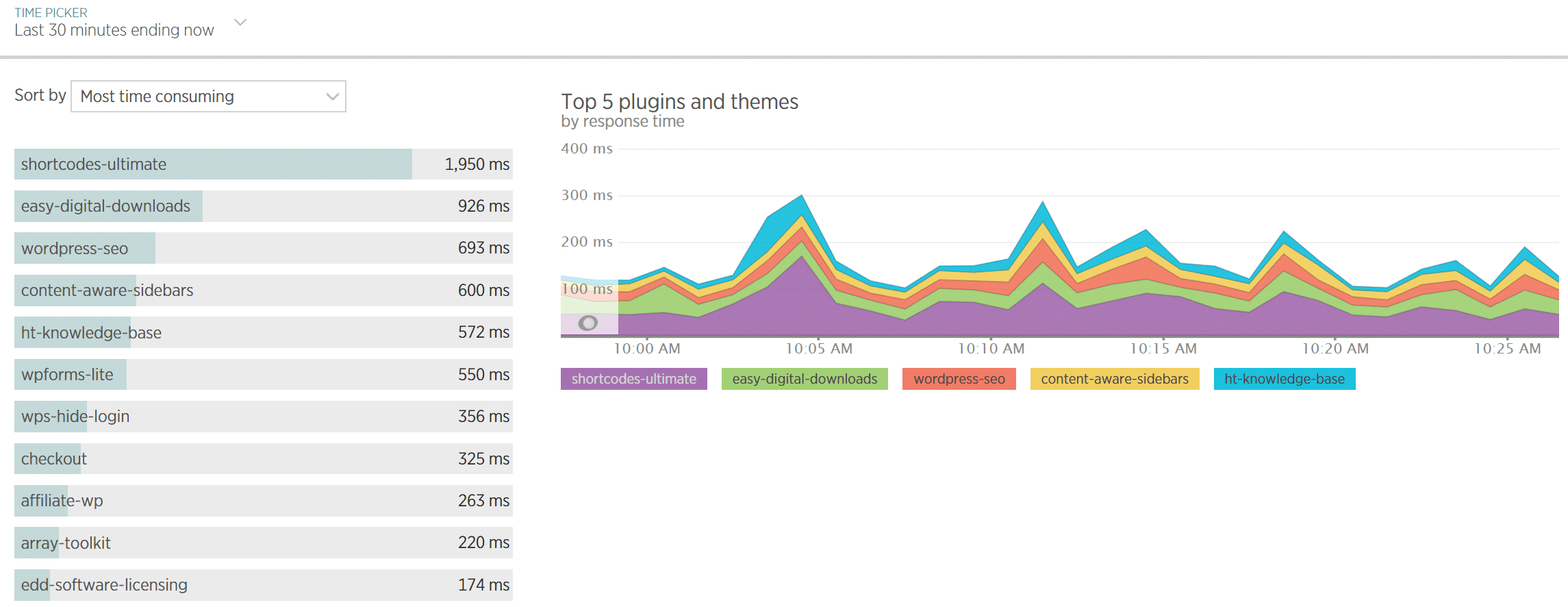
If your website starts to slow down, you can easily see this with New Relic and get notified so you can take immediate action to see what might be causing the issue. This also includes viewing external services or ad networks that might be slowing down your site. New Relic has been a great tool for us to ensure we provide the best support for our WordPress customers.

Website speed is important. ? The faster it is, the better your chances of success.
Summary
Understanding how to properly speed test your WordPress site will ensure you are gauging your performance effectively. Especially if you’re trying to measure how fast your site is after you migrate to Kinsta. ?
If a lightning-quick website is your priority – and it should be! – make sure you’re using at least one of these tools to quantitatively measure your speed optimization strategy. By now, it should be abundantly clear: website speed is an important component of any successful website. The faster your website, the better your chances of success.
What tools do you use for measuring website speed? Share them in the comments below!
Source : Kinsta



Recent Comments